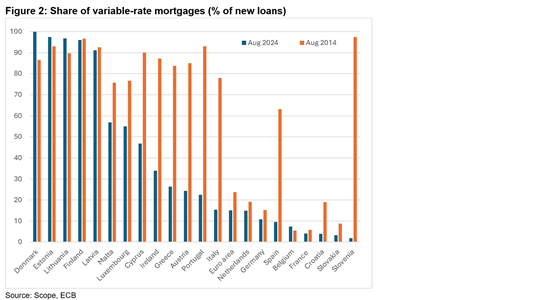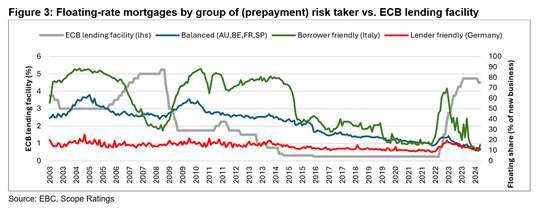Announcements
Drinks

Divergent household strategies to optimise borrowing costs may put financial stability at risk
By Mathias Pleissner, Deputy Head, Covered Bonds
Over the past decade, the share of long-term fixed-rate mortgages has risen significantly. Although higher rates have recently started to reverse this trend, structural differences in Europe have led to a range of rate-management strategies among households and lenders. As of August 2024, almost three quarters of new mortgages in Europe had initial fixings of five years and above, while half had fixed-rate periods of 10 years or more, insulating borrowers against affordability shocks. The share of long-dated fixes has almost doubled since 2009.
The share of floating-rate mortgages is mainly driven by the cost of borrowing (Figure 1) but there is substantial variation across Europe (Figure 2). Households across Europe have adopted different strategies to optimise borrowing costs, a somewhat counterintuitive outcome given that all euro-area floating-rate mortgages are linked to the European Central Bank base rate. Several factors may explain the difference in approach.

Who bears prepayment costs?
Interest-rate dynamics significantly impact borrower behaviour. When interest rates fall, the expectation is that borrowers will prepay fixed-rate mortgages to refinance at lower rates. But when loans are prepaid, banks can suffer severe present-value losses at the same time as they face reinvestment risk from lower rates. But it is not always the bank that has to bear prepayment risks.
National regulations vary widely in determining whether lenders require borrowers to compensate them if a mortgage is terminated before the end of the contractually agreed interest-fixing date. In some European countries, prepayment risk is predominantly borne by lenders while in others, borrowers may be responsible for part or all the associated costs.
Germany is lender friendly: prepayment risk resides with borrowers, who must compensate lenders for the loss of interest and even loss of margin. In contrast, countries like Belgium, France, Spain and Austria, adopt a more balanced approach. Borrowers’ liability is typically limited to a one-off payment of a few basis points or a few months of interest payments; the rest is taken by lenders. Borrower-friendly jurisdictions, such as in Italy, have no prepayment penalties hence banks take present-value hits if they do not hedge their exposures.
Consequently, borrower behaviour in lender-friendly jurisdictions tends to be stickier when it comes to variable-rate mortgages, since households are not able to benefit from moving market rates. For instance, over the last 20 years, the proportion of floating-rate mortgages in Germany has moved in a 10% to 20% bound.
By contrast, Italy exhibits a high degree of volatility in floating-rate mortgages and is more heavily correlated to the level of interest rates and borrowers’ rate expectations. When interest rates peak, or where expectations lean towards declining rates, Italian borrowers typically switch into floating-rate products and vice versa. In markets where prepayment risk is more balanced, borrower behaviour follows similar directions as Italy, but in a far less pronounced manner.
Managing prepayment risk, a complex exercise
In borrower-friendly countries, lenders need to manage pre-payment risk but hedging it can be costly, particularly for smaller banks. One option is to transfer the risk to third parties. In the US, mortgage agencies Fannie Mae and Freddie Mac manage prepayment risk by transferring it to investors. In Denmark, mortgage banks can issue covered bonds (SDRO) under the balance principle, which effectively leads to a pass-through of all interest and principal cash flows to covered bond investors, who ultimately take most of the repayment and refinancing risk.
However, the Danish balance principle is not mirrored elsewhere in Europe, and Europe lacks mortgage agencies as in the US. For many European banks, an easy solution is to offer floating-rate mortgages, which transfer refinancing risk to borrowers. Most households lack the means or know-how to hedge against sudden changes in interest rates, which may put pressure on markets predominantly exposed to floating-rate mortgages.
In its financial stability report of May 2024, Sweden’s Riksbank stated that high household indebtedness and short interest-rate fixes have had a major impact on economic growth as consumption has clearly declined. Meanwhile, the “Household Budget Survey” from Statistics Finland at the end of 2023 noted that young families with variable-rate mortgages and significant outgoings have faced the most difficulties when rates were going up. Inflation has pushed these families into a corner with long-term consequences.
Fixed-for-life mortgages with some pre-payment flexibility reduce the risk of payment shocks for borrowers, which is favourable from a pure credit risk point of view. This model has also proven to be manageable by banks. The onus here lies with national legislators and regulators to introduce rules balancing prepayment risks or limiting variable-rate loan exposure. By promoting such frameworks policymakers can safeguard both household financial security and broader economic stability.
Stay up to date with Scope’s ratings and research by signing up to our newsletters across credit, ESG and funds. Click here to register.







